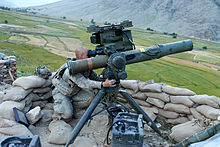| BGM-71 TOW | |
|---|---|
 An M41 tripod-mounted TOW ITAS-FTL with PADS of the U.S. Army in Kunar Province, Afghanistan, May 2009 | |
| Type | Anti-tank missile |
| Place of origin | United States |
| Service history | |
| In service | 1970–present |
| Used by | See Operators |
| Wars |
|
| Production history | |
| Designer | Hughes Aircraft Company |
| Designed | 1963–1968 |
| Unit cost | $93,640 (2B Aero), $54,956 (Bunker Buster) FY2021[5] £8,500 (1984)[6] |
| No. built | > 700,000[7] |
| Specifications | |
| Length | 1.16–1.17 m with probe folded 1.41–1.51 m with probe extended (some variants have no probe) |
| Diameter | 152 mm |
| Wingspan | 0.46 m |
| Warhead weight | 3.9–6.14 kg (penetration 430–900 mm RHA)[8] |
Operational range | Basic TOW 3,000 m, most variants 3,750 m |
| Maximum speed | 278–320 m/s |
Guidance system | Optically tracked, wire-guided (wireless radio-guided in RF variants) |
The BGM-71 TOW ("Tube-launched, Optically tracked, Wire-guided", pronounced /ˈtoʊ/)[9] is an American anti-tank missile. TOW replaced much smaller missiles like the SS.10 and ENTAC, offering roughly twice the effective range, a more powerful warhead, and a greatly improved semi-automatic command to line of sight (SACLOS) that could also be equipped with infrared cameras for night time use.
First produced in 1970, TOW is one of the most widely used anti-tank guided missiles.[10] It can be found in a wide variety of manually carried and vehicle-mounted forms, as well as widespread use on helicopters. Originally designed by Hughes Aircraft in the 1960s, the weapon is currently produced by RTX.
- ^ FUNKER530 – Veteran Community & Combat Footage (28 December 2011). "DOUBLE BARREL TOW MISSILE HEADED FOR INSURGENTS – NO SLACK". Archived from the original on 25 November 2013 – via YouTube.[better source needed]
- ^ a b "Etat islamique: comment les djihadistes emploient les missiles antichars pour appuyer leurs offensives". France-Soir (in French). 4 May 2017. Archived from the original on 1 May 2017. Retrieved 6 September 2018.
- ^ "TOW 2B used in Ukrainian soldier". Archived from the original on 31 March 2023. Retrieved 30 April 2023.
- ^ "Pakistani troops use a BGM-71 TOW to destroy an Indian Bunker". YouTube.
- ^ "Missile Procurement, Army (FY2021)" (PDF).
- ^ Pattie, Geoffrey (10 July 1984). "Weapons and Equipment (Costs)". millbanksystems. Archived from the original on 17 June 2016. Retrieved 21 May 2016.
- ^ "US Army orders TOW missiles from Raytheon under contracts totalling $676 million".
- ^ ARG. "TOW Anti-Tank Guided Missile – Military-Today.com". military-today.com. Archived from the original on 22 September 2017.
- ^ "Official US Army history of TOW (9th paragraph)". Archived from the original on 3 July 2015.
- ^ "M-220 Tube-launched, Optically-tracked, Wire-guided missile (TOW)". fas.org. Archived from the original on 3 November 2013. Retrieved 2 November 2013.